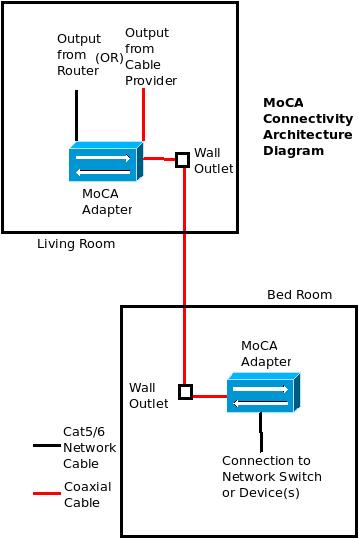MoCA: Carry Data & Video over Coaxial Lines

MoCA stands for Multimedia over Coax Alliance. It’s a technology that enables coaxial lines (provided for Cable TV) to carry data, voice and video inside a home/small office. It’s an alternative to wired/wireless/powerline networking technologies.
Advances in home networking segment (such as this) might have applications in remote offices/factories, as well. For example, if a remote home-turned-office has coaxial cables running within, it is possible to create a computer network (LAN) using it, with MoCA adapters that can carry data, voice and video.
Wired network (using copper twisted pair cables – Cat 6/7) is the best option any day. But it may not be required at all places, and creating a new network might be expensive/not feasible. Wireless network, though convenient, has its speed/capacity limitations, disconnection problems and dead spot issues. Powerline networks that carry data over the power lines/electrical cables is an option, with its own advantages and limitations. Similarly, MoCA is an alternative to create a data network using coaxial cables.
MoCA – Multimedia over Coax Alliance
MoCA 1.0/1.1 standard supports data rates of up to 135 Mbps/175 Mbps, respectively. This technology uses 50 Mhz channels in the 850 – 1525 Mhz spectrum. Since it operates above 500 Mhz, interference, cross talk and noise maybe less. MoCA encrypts signals automatically.
MoCA 2.0 is the recent standard that supports data rates up to 400 Mbps (baseline mode) or 800 Mbps (enhanced mode). The higher bandwidth is achieved by expansion of operating channel bandwidth to 100 Mhz and channel bonding.
MoCA 2.0 supports QoS & priority control with three traffic channels – High (voice), Medium (streaming media), Low (Interactive and best effort). It supports Sleep and Standby modes. This technology is backward compatible with MoCA 1.0/1.1.
MoCA Data Network: IP Over Coax!
One can create a point to point network between two Ethernet devices using coaxial cables running between them, using MoCA adapters, as shown in the above diagram. One can also create point to multi-point (full mesh, peer-to-peer) network to connect multiple Ethernet devices.
MoCA data channel supports up to 16 nodes, which can be a combination of different MoCA certified products like adapters, routers, etc. The maximum distance between root unit and last unit is 300 feet. One device (typically a STB or router) acts as a network controller.
MoCA for Video
Think about this – Coaxial cables were used extensively to carry video signals for many years. MoCA, hence, is optimized to carry high-bandwidth low-latency HD video. MoCA is also approved by DLNA for media discovery and streaming.
Hence – just my thoughts – MoCA maybe useful in enterprises and small businesses to carry the bandwidth intensive video conference/video surveillance signals using a separate coaxial cable network, without gobbling up a lot of bandwidth on the regular network, freeing it up for other applications.
Of course, there are limitations: No. of devices that can be connected to this network, limited bandwidth carrying capacity, cost of creating and maintaining a new network, etc. At the least, MoCA can be considered as an effective alternative to wired, wireless, powerline networks for a few applications.
excITingIP.com
You could stay up to date on Computer Networking/IT Technologies by subscribing to this blog with your email address in the sidebar box that says, ‘Get email updates when new articles are published’.